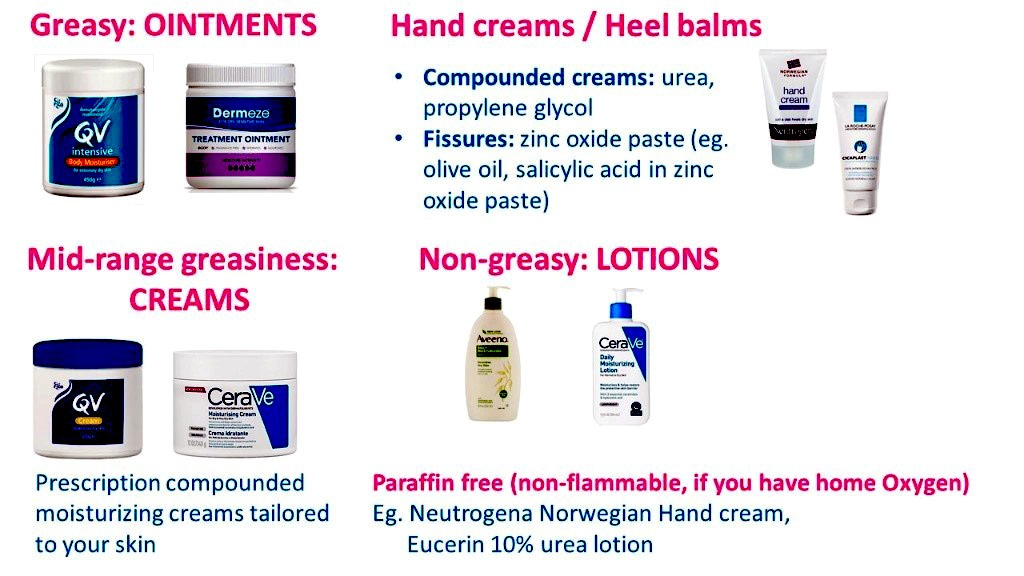As an expert in Scleroderma (Morphoea and Systemic Sclerosis), patients ask me many questions about the skin and how it can affect day to day activities. I thought I’d address some of them here for you.
I have Scleroderma (Systemic Sclerosis or morpheoa), what is the best moisturizer for my skin?
This is an easy one – the best moisturizer is the one that you like. Truly, it is often that simple. If you like it, you will use it, and that means the moisturizer will be able to do its job to hydrate your skin. If you don’t like your moisturizer, then you’ll be less inclined to apply it or to use an adequate amount.
Moisturizers come in lotions, creams and ointments. Each has pros and cons. Lotions are runnier, lighter and so ‘rub in’ more easily. However lotions are also less hydrating to the skin. Creams are mid-range. They tend to rub in fairly well, but are thicker than lotions and so will generally be more hydrating overall. Ointments are the thickest and are therefore quite greasy. They are the most hydrating and hence best for very dry skin, however they can feel sticky, leave stains on clothes or sheets and block the pores in acne or folliculitis prone skin. I’ve summarised some of this here, with some example products. In any inflammatory skin condition, such as Scleroderma, it is best to avoid skin products with fragrances and also a lot of ‘natural’ products like lavender and extracts from fruits / vegetables, as these can irritate inflamed skin.
Often, especially in Systemic Sclerosis, the skin can be quite dry, and so using a slightly thicker cream or ointment may be most beneficial. However this can change at certain times, with the activity of your skin condition and even with the weather.
I always like to provide my patients with lots of samples of different moisturizers so that you can try them and see which you like best. I discuss some of the different ingredients in various products and we can select moisturizers which might be best for your specific skin needs. The key overall though, as I said, is to find one you like, as then you will use it.
My feet burn and it feels like I’m walking on stones – can you help this?
Many of my patients with Systemic Sclerosis complain of very uncomfortable burning in the soles of their feet, and pain when walking. Changes in the feet in Systemic Sclerosis cause loss of the fat pad on the soles. This means the feet can become extremely painful – like walking on pebbles.
It’s a tricky problem, but some advice:
- Keep the feet warm; ‘silver socks’, thermal socks, heat pads (from the chemist), thermal insoles
- Insoles for your shoes for extra cushioning, made to measure; see a Podiatrist
- Buy supportive foot wear; eg. foam soles
What anti-aging products can I use if I have Scleroderma?
Generally speaking, you can use most anti-aging creams and serums if you have Systemic Sclerosis (SSc).
There is no evidence that collagen promoting or Hyaluronic acid type products or supplements should definitely be avoided in SSc, however my advice to my patients is that it is likely best to avoid these, given the underlying problem in SSc is overproduction of collagen / fibrosis.
The only other key point I think is to just remember that you potentially have inflamed skin if you have SSc, and inflamed skin is often more prone to dryness and irritation. A lot of anti-aging active ingredients like Vitamin A (retinols or prescription retinoids) and Vitamin C will actively dry and irritate the skin. It is therefore best to start with low concentrations, use them infrequently, and build up slowly to see how your skin tolerates these ingredients.
Vitamin B3 (aka Niacinamide) is one ingredient (which is also anti-redness, anti-acne, anti-bacterial, anti-inflammatory, anti-skin cancer – I recommend B3 both topically and as an oral supplement) which does not tend to dry or irritate the skin. So it may be an idea to start with this.
Lastly, and importantly, the key to any anti-aging routine, is sun protection. Wear a hat, long sleeves, be protected by the shade whenever you can, and regularly apply an adequate amount of a 50+ broad spectrum sunscreen (with a physical blocker like zinc oxide or iron oxide especially if you are prone to pigmentation).
Overall though, everyone’s skin is different, and it is best that you discuss your individual needs with a Dermatologist who is well versed in both SSc and general anti-aging skin care.
Should I be extra careful in the sun if I have Scleroderma?
The Australian sun is powerful. So you should always wear a 50+ broad spectrum sunscreen and physical protectors from the sun wherever you can including a hat, long sleeves and shade.
However, SSc and Morphoea are not photosensitive conditions (ie. they are not triggered or necessarily made worse by sunlight), which means there are no additional precautions you need to take specific to these conditions.
The exception to this is if you are prone to pigmentation. This happens in Systemic Sclerosis and Morphoea, as a consequence of the inflammation. In this case, you should be extra careful, as the sun will promote worsening of this pigmentation. Ideally shade, a hat and long sleeve clothing are the best protection. However at times when you cannot avoid sun exposure, you should choose a sunscreen with a physical blocker in it. Physical blockers are ingredients such as zinc oxide or iron oxide in sunscreens, which are particularly good at limiting pigmentation.
Written by AProf Amanda Saracino
© 2023 AProf Amanda Saracino




